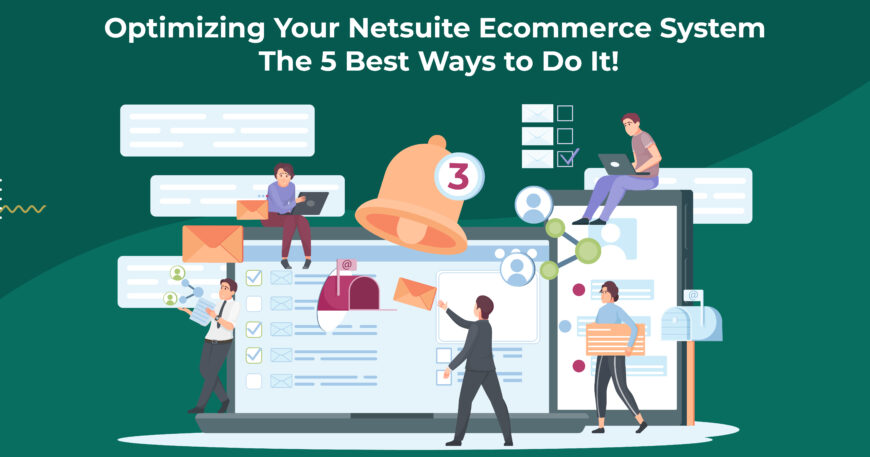Are you looking for ways to improve your Netsuite ecommerce system? As your business grows, it’s essential to keep your system up to date. With proper optimization and an expert Netsuite developer, your ecommerce store may become more active and easier to manage. So, how can you optimize your Netsuite ecommerce system?
Netsuite is a popular platform for ecommerce businesses, offering a range of features for managing online storefronts. However, many business owners need help optimizing their Netsuite system to keep up with demand. With many options available, figuring out where to start can take time.
To help you, we’ve compiled a list of the 5 best ways to optimize your ecommerce Netsuite system. From streamlining your checkout process to integrating with third-party apps, these tips will help you improve the performance of your ecommerce store and enhance the customer experience. Read on to learn more.
1. Optimize NetSuite for Better Ecommerce Performance
To optimize Netsuite for better ecommerce performance, businesses should begin by reviewing the platform’s capabilities and assessing whether it can meet their ecommerce requirements. This involves evaluating the features, functionalities, and integrations available with Netsuite. Once a business has determined that Netsuite is the right ecommerce platform for them, they can move on to setting it up and customizing it to meet their specific needs.
Optimization involves configuring the platform, such as setting up product catalogs, configuring shipping and payment options, and customizing the checkout process. To further improve ecommerce performance, businesses should focus on enhancing website performance and customer experience.
Tips for optimizing website performance include minimizing load times, optimizing images, and using responsive design. Improving customer experience can consist of personalized recommendations, customer reviews, and live chat support.
2. Streamlining Processes for NetSuite Ecommerce
NetSuite is a cloud-based enterprise resource planning (ERP) system that offers various features for e-commerce businesses. Here are some points about streamlining processes for NetSuite e-commerce that can help businesses save time, reduce errors, and improve overall efficiency.
Automating order fulfillment processes is possible with NetSuite Ecommerce, allowing businesses to automatically create sales orders, generate invoices, and update inventory levels in real time. Enhancing shipping and tracking capabilities is another feature of NetSuite Ecommerce integration that allows businesses to integrate with various shipping carriers and offer real-time tracking information to customers.
Additionally, NetSuite Ecommerce integrations allow businesses to integrate with various payment processing and tax calculation services such as PayPal, Stripe, and Avalara, streamlining the payment and tax calculation process while reducing errors and improving accuracy.
3. Personalizing Customer Interactions with NetSuite Ecommerce
Personalization has become a key component of successful e-commerce strategies, and businesses can leverage NetSuite’s features to personalize customer interactions. NetSuite enables businesses to collect and analyze customer data such as purchase history, browsing behavior, and demographic information to create targeted marketing campaigns and personalized customer experiences. This includes personalized product recommendations, targeted promotions, and customized content.
Additionally, NetSuite’s comprehensive customer relationship management (CRM) system offers support tools such as case management, knowledge management, and self-service portals. These tools allow businesses to provide efficient and personalized customer service. For example, businesses can use case management to track customer inquiries and provide personalized responses. In contrast, knowledge management can be used to create a centralized knowledge base that customers can access for self-service support. By utilizing NetSuite’s e-commerce capabilities, businesses can enhance customer engagement, loyalty, and retention.
4. Improving NetSuite Ecommerce Reporting and Analytics
NetSuite’s reporting and analytics tools offer businesses a wide range of capabilities to gain insights into their e-commerce operations. One of the key ways to improve e-commerce reporting and analytics is by using the key performance indicators (KPIs) that NetSuite offers, such as website traffic, conversion rates, average order value, and customer lifetime value. By monitoring these KPIs, businesses can identify areas for improvement.
Another way to improve reporting and analytics is by creating custom reports and dashboards using best practices. This includes identifying the most relevant data for the business, choosing appropriate visualization tools, and regularly reviewing and updating the reports. NetSuite offers various analytics tools, such as SuiteAnalytics and SuiteFlow, that businesses can use to gain insights and automate workflows based on data insights.
To drive decision-making using these tools, businesses need to ensure that their data is accurate and up-to-date, regularly review and analyze their reports, and use the insights gained to inform their decision-making. By leveraging NetSuite’s reporting and analytics tools, businesses can better understand their e-commerce operations and make data-driven decisions to improve their performance.
5. Staying Ahead of the Competition with NetSuite Ecommerce
Staying ahead of the competition in ecommerce requires keeping up with industry trends, incorporating new features, and leveraging NetSuite’s ecommerce capabilities. NetSuite is committed to constantly improving its ecommerce platform to meet changing market trends and customer demands, with recent developments including improved search functionality, mobile optimization, and social media integration.
Attending industry events and conferences and reading industry publications and blogs are essential to staying current with industry trends. Incorporating new features into your NetSuite ecommerce strategy requires identifying the most relevant segments to your business and customers, testing new features before implementing them fully, and ensuring they are user-friendly and practical.
NetSuite’s ecommerce platform offers a wide range of capabilities to help businesses stay ahead of the competition, including personalized shopping experiences, real-time inventory management, and cross-channel order fulfillment. By leveraging these capabilities, businesses can provide their customers with a seamless and efficient ecommerce experience that sets them apart from their competitors.
Conclusion
Optimizing your Netsuite ecommerce system can be a game-changer for your business. By following the tips outlined in this blog post, you can ensure that your ecommerce system runs smoothly and efficiently. From streamlining your order management process to improving website performance and enhancing customer experience, there are many ways to optimize your Netsuite ecommerce system.
Remember to regularly review and analyze data to identify areas for improvement and stay up-to-date with the latest trends and technologies in ecommerce. With the right approach, you can achieve long-term success and growth for your business with a well-optimized Netsuite ecommerce system.





